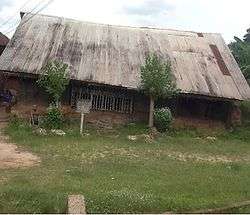Okoroji House Museum
The Okoroji House Museum or Okoroji House, (Igbo: Ulo Nta Okoroji, Ogbuti Okoroji), is a historic house and museum located in Ujari, a village in Arochukwu, Abia State, Eastern Nigeria.[1] The house was declared a national monument in 1972 by the National Commission for Museums and Monuments.[2]

External view of Chief Okoroji House
History and structure
The house was built during the 17th century by Maazi Okoroji Oti, a local chief and slave merchant, who was active during the trans-atlantic slave trade.[1] The house is made of mud while its roof is made of aluminium zinc. The interior showcases various sacred shrine objects, historical artifacts, slave chains, brass manillas, swords and guns.[3][4]
gollark: In the name of equality, we must REMOVE ALL THE WALLS OF IT.
gollark: Accidentally killed my X server, back now.
gollark: why do you want that?
gollark: ærch linux hæs a zen kernel øption.
gollark: How many multmines to the gold ingot is it now?
References
- Uguru, Okorie (27 June 2015). "Okoroji House Gateway to the past". The Nation News. Retrieved 1 September 2016.
- G. Ugo Nwokeji (13 September 2010). The Slave Trade and Culture in the Bight of Biafra: An African Society in the Atlantic World. Cambridge University Press. pp. 104–. ISBN 978-1-139-48954-6.
- Zbigniew R. Dmochowski (1990). An Introduction to Nigerian Traditional Architecture: South-Eastern Nigeria, the Igbo-speaking Areas. Ethnographica Limited. ISBN 978-0-905788-28-9.
- "Chief Okoroji's House, Arochukwu". www.zodml.org. Retrieved 1 September 2016.
This article is issued from Wikipedia. The text is licensed under Creative Commons - Attribution - Sharealike. Additional terms may apply for the media files.